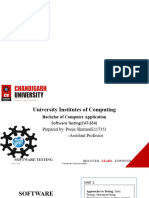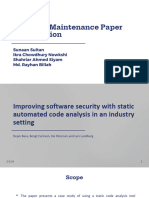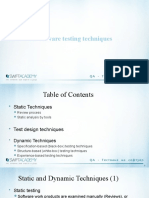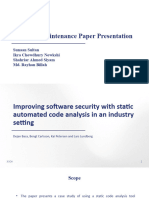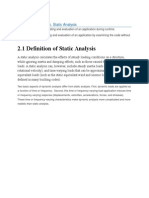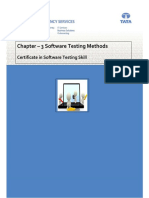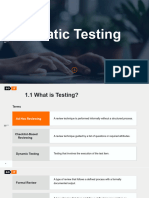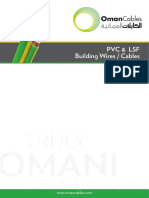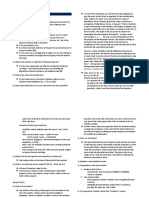Software Analysis and Testing: Static and
Dynamic Analysis
Software analysis and testing are essential processes in software development to ensure
quality, reliability, and performance. Analysis techniques like static and dynamic analysis are
used to detect defects, verify compliance with requirements, and optimize the code. Testing
validates the functionality of the software and ensures it meets user expectations.
1. Software Analysis focuses on examining software artifacts to detect errors and
optimize performance.
2. Static Analysis evaluates code without executing it.
3. Dynamic Analysis tests the software during execution.
4. Both analysis methods are integral to quality assurance.
Static Analysis
Definition
Static analysis involves examining the source code, design documents, or other artifacts
without executing the program. It is often automated using tools.
Characteristics
1. Conducted early in the development lifecycle.
2. Identifies syntax errors, security vulnerabilities, and code smells.
3. Useful for ensuring coding standards and maintainability.
Techniques
1. Code Reviews: Manual inspection of code by developers.
2. Linting: Automated tools (e.g., ESLint, PyLint) check for errors.
3. Model Checking: Verifies formal properties of algorithms.
4. Static Code Analysis Tools: Tools like SonarQube and Fortify analyze source code.
Advantages of Static Analysis
1. Detects issues early in development.
2. Improves code quality and maintainability.
3. Reduces the cost of fixing defects.
4. Ensures compliance with coding standards.
Disadvantages of Static Analysis
1. Limited to finding certain types of defects (e.g., runtime errors may be missed).
2. False positives can occur.
3. Requires expertise to interpret results effectively.
Dynamic Analysis
Definition
Dynamic analysis evaluates a program by executing it in a controlled environment to observe
its behavior and identify runtime errors.
Characteristics
1. Conducted after the program is partially or fully implemented.
2. Detects runtime issues such as memory leaks, performance bottlenecks, and crashes.
3. Requires input data and test cases to execute.
Techniques
1. Unit Testing: Testing individual units of code.
2. Integration Testing: Evaluating the interaction between integrated modules.
3. System Testing: Verifying the complete system functionality.
4. Performance Testing: Assessing system performance under different conditions.
5. Debugging: Identifying and fixing runtime errors.
Advantages of Dynamic Analysis
1. Identifies runtime and logical errors.
2. Ensures the software behaves as expected in real-world scenarios.
3. Helps optimize performance and resource usage.
Disadvantages of Dynamic Analysis
1. Requires executable code and test cases.
2. Can be time-consuming.
3. May not cover all code paths without comprehensive test cases.
Diagram/Representation
Static vs. Dynamic Analysis Workflow
Static Analysis: Code ---> Analyze ---> Report Issues
Dynamic Analysis: Execute Code ---> Monitor ---> Identify Issues
Conclusion
Static and dynamic analysis are complementary approaches in software quality assurance.
While static analysis ensures the code is clean, secure, and adheres to standards, dynamic
analysis validates its runtime behavior and performance. Together, they provide a holistic
framework for delivering robust, reliable, and efficient software solutions.



















